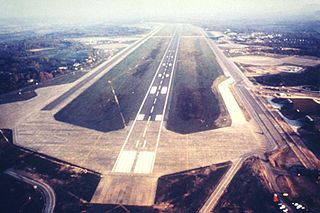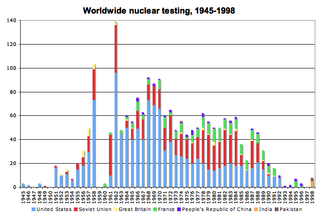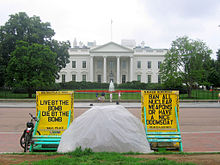
Nuclear disarmament is the act of reducing or eliminating nuclear weapons. Its end state can also be a nuclear-weapons-free world, in which nuclear weapons are completely eliminated. The term denuclearization is also used to describe the process leading to complete nuclear disarmament.

Royal Air Force Greenham Common or more simply RAF Greenham Common is a former Royal Air Force station in the civil parishes of Greenham and Thatcham in the English county of Berkshire. The airfield was southeast of Newbury, about 55 miles (89 km) west of London.

Swords to ploughshares is a concept in which military weapons or technologies are converted for peaceful civilian applications.

His Majesty's Naval Base, Clyde, primarily sited at Faslane on the Gare Loch, is one of three operating bases in the United Kingdom for the Royal Navy. It is the navy's headquarters in Scotland and is best known as the home of Britain's nuclear weapons, in the form of nuclear submarines armed with Trident missiles.
Stop the City demonstrations of 1983 and 1984 were described as a 'Carnival Against War, Oppression and Destruction', in other words protests against the military-financial complex. These demonstrations can be seen as the forerunner of the anti-globalisation protests of the 1990s, especially those in London, England, on May Day and the Carnival against Capitalism on 18 June 1999. They were partially inspired by the actions of the Greenham Common Women's Peace Camp.
Faslane Peace Camp is a permanent peace camp sited alongside Faslane Naval base in Argyll and Bute, Scotland. It has been occupied continuously, in a few different locations, since 12 June 1982. In 1984, the book Faslane:Diary of a Peace Camp was published, co-written by the members of the peacecamp at the time. There is also a secondary site on Raeberry Street in North Glasgow.

Greenham Common Women's Peace Camp was a series of protest camps established to protest against nuclear weapons being placed at RAF Greenham Common in Berkshire, England. The camp began on 5 September 1981 after a Welsh group, Women for Life on Earth, arrived at Greenham to protest against the decision of the British government to allow cruise missiles to be stored there. After realising that the march alone was not going to get them the attention that they needed to have the missiles removed, women began to stay at Greenham to continue their protest. The first blockade of the base occurred in March 1982 with 250 women protesting, during which 34 arrests occurred.

Royal Naval Armaments Depot Coulport, shortened to RNAD Coulport, on Loch Long in Argyll, Scotland, is the storage and loading facility for the nuclear warheads of the United Kingdom's Trident programme.
The Seneca Women's Encampment for a Future of Peace and Justice was a women-only peace camp formed to protest the scheduled deployment of Cruise and Pershing II missiles before their suspected shipment from the Seneca Army Depot to Europe in the fall of 1983.
The Aldermaston marches were anti-nuclear weapons demonstrations in the 1950s and 1960s, taking place on Easter weekend between the Atomic Weapons Research Establishment at Aldermaston in Berkshire, England, and London, over a distance of fifty-two miles, or roughly 83 km. At their height in the early 1960s they attracted tens of thousands of people and were the highlight of the Campaign for Nuclear Disarmament (CND) calendar. Similar demonstrations also took place around the world.

The anti-nuclear movement in the United Kingdom consists of groups who oppose nuclear technologies such as nuclear power and nuclear weapons. Many different groups and individuals have been involved in anti-nuclear demonstrations and protests over the years.

A peace movement is a social movement which seeks to achieve ideals such as the ending of a particular war or minimizing inter-human violence in a particular place or situation. They are often linked to the goal of achieving world peace. Some of the methods used to achieve these goals include advocacy of pacifism, nonviolent resistance, diplomacy, boycotts, peace camps, ethical consumerism, supporting anti-war political candidates, supporting legislation to remove profits from government contracts to the military–industrial complex, banning guns, creating tools for open government and transparency, direct democracy, supporting whistleblowers who expose war crimes or conspiracies to create wars, demonstrations, and political lobbying. The political cooperative is an example of an organization which seeks to merge all peace-movement and green organizations; they may have diverse goals, but have the common ideal of peace and humane sustainability. A concern of some peace activists is the challenge of attaining peace when those against peace often use violence as their means of communication and empowerment.

Anti-nuclear protests began on a small scale in the U.S. as early as 1946 in response to Operation Crossroads. Large scale anti-nuclear protests first emerged in the mid-1950s in Japan in the wake of the March 1954 Lucky Dragon Incident. August 1955 saw the first meeting of the World Conference against Atomic and Hydrogen Bombs, which had around 3,000 participants from Japan and other nations. Protests began in Britain in the late 1950s and early 1960s. In the United Kingdom, the first Aldermaston March, organised by the Campaign for Nuclear Disarmament, took place in 1958. In 1961, at the height of the Cold War, about 50,000 women brought together by Women Strike for Peace marched in 60 cities in the United States to demonstrate against nuclear weapons. In 1964, Peace Marches in several Australian capital cities featured "Ban the Bomb" placards.

The application of nuclear technology, both as a source of energy and as an instrument of war, has been controversial.
Helen John was one of the first full-time members of the Greenham Common peace camp in England, UK, and was an peace activist for over 30 years.

The Campaign for Nuclear Disarmament (CND) is an organisation that advocates unilateral nuclear disarmament by the United Kingdom, international nuclear disarmament and tighter international arms regulation through agreements such as the Nuclear Non-Proliferation Treaty. It opposes military action that may result in the use of nuclear, chemical or biological weapons, and the building of nuclear power stations in the UK.
Atomic, Living in Dread and Promise is a documentary film about nuclear history directed by Mark Cousins and Produced by Heather Croall, Mark Atkin and John Archer. It uses only archive footage to explore life and death in the atomic age. The band Mogwai created the original soundtrack. The film, with a live performance by Mogwai, closed the Edinburgh International Festival in 2016. It was then shown on BBC Storyville to mark 70 years since the bombing of Hiroshima. The soundtrack was subsequently reworked by Mogwai into a studio album, Atomic.

Rebecca Johnson is a British peace activist and expert on nuclear disarmament. She is the director and founder of Acronym Institute for Disarmament Diplomacy as well as a co-founding strategist and organiser of the International Campaign to Abolish Nuclear Weapons.
Sarah Hipperson was a midwife, magistrate and peace campaigner who spent 17 years living at the Greenham Common Women's Peace Camp on RAF Greenham Common protesting against the siting of American nuclear cruise missiles in the United Kingdom. In 1982, she founded Catholic Peace Action. Her nonviolent resistance resulted in over 20 imprisonments and several appearances in court. She lived to see the transformation of Greenham Common back into use by the public and was one of the last four women to leave the camp. She appeared as herself in the documentary Margaret Thatcher: The Woman Who Changed Britain.
Eunice Stallard was a political and community activist in Wales. She was active in the Labour Party, involved in several peace movements, notably at Greenham Common in 1981 and organised community support during the 1984 - 1985 miner's strike. A Purple Plaque to mark her life was installed in Ystradgynlais in 2020.













